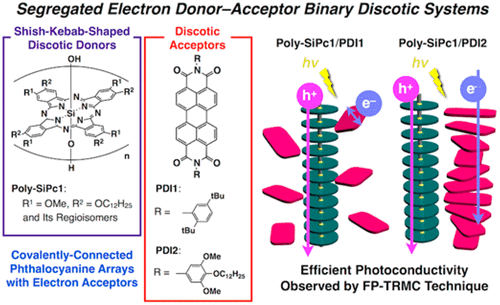当前位置:
X-MOL 学术
›
Macromolecules
›
论文详情
Our official English website, www.x-mol.net, welcomes your
feedback! (Note: you will need to create a separate account there.)
Donor/Acceptor Segregated π-Stacking Arrays by Use of Shish-Kebab-Type Polymeric Backbones: Highly Conductive Discotic Blends of Phthalocyaninatopolysiloxanes and Perylenediimides
Macromolecules ( IF 5.1 ) Pub Date : 2017-11-20 00:00:00 , DOI: 10.1021/acs.macromol.7b02020 Tsuneaki Sakurai 1 , Satoru Yoneda 2 , Shugo Sakaguchi 1 , Kenichi Kato 3 , Masaki Takata 3 , Shu Seki 1
Macromolecules ( IF 5.1 ) Pub Date : 2017-11-20 00:00:00 , DOI: 10.1021/acs.macromol.7b02020 Tsuneaki Sakurai 1 , Satoru Yoneda 2 , Shugo Sakaguchi 1 , Kenichi Kato 3 , Masaki Takata 3 , Shu Seki 1
Affiliation

|
Construction of large-area electron donor–acceptor (D–A) interfaces and hole/electron pathways is important for photoconducting and photovoltaic functions. Although blends of D- and A-type discotic π-systems have a possibility to realize one-dimensional charge carrier pathways as well as heterointerfaces, D–A segregated structures are difficult to develop by self-assembly because they are entropically unfavored structures. Here we report the use of shish-kebab-type hole-transporting discotic columns fixed by a self-threading polysiloxane chain and approach to such segregated nanostructures. Electron-donor/acceptor blends of soluble phthalocyaninatopolysiloxanes (Poly-SiPcs) and perylenedicarboximides (PDIs) were prepared, and their photoconductive property was investigated. Although Poly-SiPc1 shows a photoinduced charge separation with PDI1 analogous to the corresponding monomeric phthalocyanines (SiPc1 and H2Pc1), the Poly-SiPc1/PDI1 system displays a remarkably larger photoconductivity than SiPc1/PDI1 and H2Pc1/PDI1, which mostly results from the presence of hole-transporting pathways with the mobility μh,1D ∼ 0.1 cm2 V–1 s–1 in Poly-SiPc1 along the polysiloxane covalent bonds even upon mixing with PDI1. When π-stackable PDI2 is used instead of PDI1, X-ray diffraction analysis disclosed obvious signs of π-stacking periodicities for both Pc and PDI planes in the mixture, indicating the presence of donor–acceptor segregated domains of columnar structures. As a result, photoexcitation of Poly-SiPc1/PDI2 generates highly mobile holes and electrons, leading to the observation of a much larger conductivity.
中文翻译:

通过使用Shish-Kebab型聚合物骨架的供体/受体隔离的π堆叠阵列:酞菁氰基聚硅氧烷和Per二酰亚胺的高导电圆盘状混合物
大面积电子给体-受体(D-A)界面和空穴/电子路径的构建对于光电导和光伏功能很重要。尽管D型和A型盘状π系统的混合物可以实现一维电荷载流子路径以及异质界面,但D–A隔离结构很难通过自组装形成,因为它们是熵的不利结构。在这里,我们报道了通过自穿线聚硅氧烷链固定的烤肉串型空穴传输盘状柱的使用,以及对这种分离的纳米结构的处理方法。制备了可溶性邻苯二甲腈基聚硅氧烷(Poly-SiPcs)和per二芳基酰亚胺(PDI)的电子给体/受体共混物,并研究了它们的光电导性能。虽然是Poly-SiPc1由于显示了与相应的单体酞菁(SiPc1和H 2 Pc1)相似的PDI1引起的光诱导电荷分离,Poly-SiPc1 / PDI1系统显示出比SiPc1 / PDI1和H 2 Pc1 / PDI1大得多的光电导率,这主要是由于存在与迁移率μ空穴传输通路小时,1D〜0.1厘米2 V -1小号-1在聚SiPc1沿所述聚硅氧烷的共价键连在与混合PDI1。当使用π可堆叠的PDI2代替PDI1时,X射线衍射分析显示混合物中Pc和PDI平面都有明显的π堆叠周期迹象,表明存在柱状结构的施主-受主分离域。结果,Poly-SiPc1 / PDI2的光激发产生高度可移动的空穴和电子,从而导致观察到更大的电导率。
更新日期:2017-11-20
中文翻译:

通过使用Shish-Kebab型聚合物骨架的供体/受体隔离的π堆叠阵列:酞菁氰基聚硅氧烷和Per二酰亚胺的高导电圆盘状混合物
大面积电子给体-受体(D-A)界面和空穴/电子路径的构建对于光电导和光伏功能很重要。尽管D型和A型盘状π系统的混合物可以实现一维电荷载流子路径以及异质界面,但D–A隔离结构很难通过自组装形成,因为它们是熵的不利结构。在这里,我们报道了通过自穿线聚硅氧烷链固定的烤肉串型空穴传输盘状柱的使用,以及对这种分离的纳米结构的处理方法。制备了可溶性邻苯二甲腈基聚硅氧烷(Poly-SiPcs)和per二芳基酰亚胺(PDI)的电子给体/受体共混物,并研究了它们的光电导性能。虽然是Poly-SiPc1由于显示了与相应的单体酞菁(SiPc1和H 2 Pc1)相似的PDI1引起的光诱导电荷分离,Poly-SiPc1 / PDI1系统显示出比SiPc1 / PDI1和H 2 Pc1 / PDI1大得多的光电导率,这主要是由于存在与迁移率μ空穴传输通路小时,1D〜0.1厘米2 V -1小号-1在聚SiPc1沿所述聚硅氧烷的共价键连在与混合PDI1。当使用π可堆叠的PDI2代替PDI1时,X射线衍射分析显示混合物中Pc和PDI平面都有明显的π堆叠周期迹象,表明存在柱状结构的施主-受主分离域。结果,Poly-SiPc1 / PDI2的光激发产生高度可移动的空穴和电子,从而导致观察到更大的电导率。











































 京公网安备 11010802027423号
京公网安备 11010802027423号